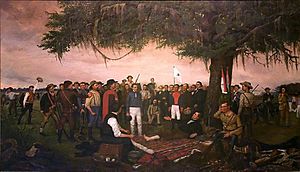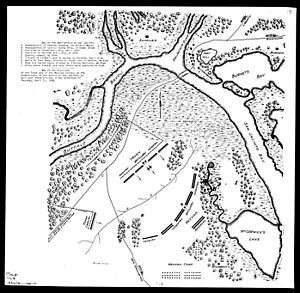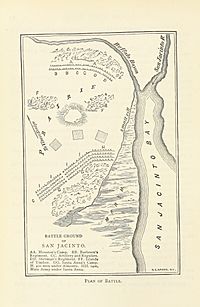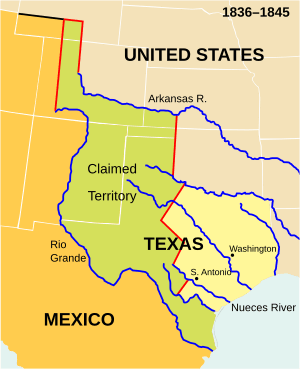Battle of San Jacinto facts for kids
Quick facts for kids Battle of San Jacinto |
|||||||
|---|---|---|---|---|---|---|---|
| Part of the Texas Revolution | |||||||
 The Battle of San Jacinto – 1895 painting by Henry Arthur McArdle (1836–1908) |
|||||||
|
|||||||
| Belligerents | |||||||
| Centralist Republic of Mexico | Republic of Texas | ||||||
| Commanders and leaders | |||||||
|
|
||||||
| Strength | |||||||
|
|
||||||
| Casualties and losses | |||||||
|
|
||||||
The Battle of San Jacinto was a very important fight during the Texas Revolution. It happened on April 21, 1836, near what is now La Porte and Deer Park, Texas. In this battle, the Texan Army, led by General Sam Houston, quickly defeated the Mexican army led by General Antonio López de Santa Anna. The whole battle lasted only 18 minutes!
General Santa Anna, who was also the president of Mexico, escaped during the battle. But he was caught the very next day. After being held as a prisoner for about three weeks, Santa Anna signed a peace treaty. This treaty made the Mexican army leave Texas. It also helped Texas become an independent country called the Republic of Texas. Even though the treaty didn't fully recognize Texas as a country, it was a big step. Sam Houston became a hero. The battle cries "Remember the Alamo" and "Remember Goliad" became famous in Texas history.
Contents
Road to Revolution: 1832–1836
Mexico's Changing Government
In 1832, General Antonio López de Santa Anna helped remove the Mexican president. He believed in a government where power was shared. But after he became president in 1833, Santa Anna changed his mind. He started making the government more powerful and centralized. This meant he had more control.
Santa Anna also got rid of Mexico's 1824 Constitution. This constitution had given states like Coahuila and Texas some local power. Taking away this power made many Texans, both Mexican-born (Tejanos) and Anglo settlers, very upset. Stephen F. Austin, a Texan leader, was even put in prison for a while because he wanted Texas to become a separate state.
Colonel Juan Almonte was sent to Texas to try and calm things down. He promised that Texas could have some self-governance. But his real job was to find out who the local leaders were and stop any plans for rebellion. He also gathered information for the Mexican government in case of a war.
General Cos Takes Control
In 1835, Santa Anna made General Martín Perfecto de Cos the military leader of Texas. Cos set up his base in San Antonio. This led to the Siege of Béxar, where Texan forces surrounded the city. After two months, Cos surrendered in December. Many Texans thought the war was over and went home.
However, Mexico's Minister of War, José María Tornel, issued a decree. It said that foreigners who joined the Texas rebellion would be treated as "pirates" and could be killed if captured. This was meant to stop people from the United States from helping Texas.
The Fall of the Alamo
Santa Anna led a large Mexican army of over 6,000 soldiers into Texas. They marched hundreds of miles to reach Béxar (San Antonio). On February 23, 1836, the Mexican army captured Béxar. They then attacked the Alamo, a fort where Texan soldiers were defending.
The Texan commander, William B. Travis, tried to negotiate, but Santa Anna refused. Santa Anna did offer safety to Tejanos inside the fort if they left. Many Tejanos took this offer. General Cos, who had surrendered earlier, also joined Santa Anna's army, which was against his surrender terms.
Meanwhile, other Mexican forces under General José de Urrea were fighting Texan groups along the coast. They won several battles, capturing or killing many Texan soldiers.
On March 1, 1836, Texan leaders met at Washington-on-the-Brazos. The next day, they signed the Texas Declaration of Independence. They also chose a temporary government. Sam Houston was given more military power.
On March 6, 1836, the Mexican army launched its final attack on the Alamo. After a fierce battle, the Alamo fell. All the Texan defenders were killed. A few survivors, like Susanna Dickinson and Travis's slave Joe, were sent to Gonzales to tell the Texan volunteers what had happened.
The Runaway Scrape
When Sam Houston arrived in Gonzales, he told the Texan volunteers that Texas was now independent. News of the Alamo's fall reached them, and they learned the Mexican army was coming. A quick decision was made to leave the area and retreat. This became known as the "Runaway Scrape."
The Texans left so quickly that they burned everything they couldn't carry. They even threw their two cannons into the river. When the Mexican army arrived, they found only smoldering ruins.
Many citizens fled on foot, carrying their children. The Texan army moved slowly because heavy rains had turned the roads into mud. As news of the Alamo spread, more volunteers joined Houston's army. By March 19, he had about 1,400 men.
Houston learned that another Texan commander, James Fannin, had surrendered his men, who were later killed in the Goliad. Houston knew his army was the last hope for Texas. He kept retreating, even though his soldiers were unhappy and called him a coward. He wanted to train his men and avoid a fight until the right moment.
On March 31, Houston's army stopped at the Brazos River. They rested, got over illnesses, and practiced military drills. Two new cannons, called the Twin Sisters, arrived. The temporary Secretary of War, Thomas Jefferson Rusk, came with orders to replace Houston if he didn't fight. But Houston convinced Rusk that his plan was good. Even though the government was pressuring him to fight, Houston waited for the right time.
Santa Anna, meanwhile, was trying to catch the Texan government officials. He believed the rebellion was almost over. He thought the Texan army would try to escape to Galveston Island. So, he ordered his army to move towards Lynchburg to block their escape.
But Houston's army changed direction. On April 18, they found out that Santa Anna had only a small force nearby. Houston gave a powerful speech, telling his men to "Remember the Alamo" and "Remember Goliad." His army then rushed towards Lynchburg. Texan soldiers of Mexican descent (Tejanos) were asked to wear playing cards in their hats so they could be easily identified as Texan soldiers.
The Battle of San Jacinto
The area around Buffalo Bayou had thick oak trees and marshes. This was good for the Texans, but confusing for the Mexican soldiers. Houston's army, about 800 men, reached Lynch's Ferry on April 20. Santa Anna's force of 700 men arrived a few hours later. The Texans set up camp in a wooded area, which hid their numbers but also left them no way to retreat.
Santa Anna chose a risky spot for his camp. It was a flat area near the San Jacinto River, with woods on one side and marsh on the other. One of his officers later wrote that the camp was "against military rules." The two camps were only about 500 yards apart.
There were two small fights that day. The Texans used their Twin Sisters cannons to make the Mexican artillery pull back. Later, the Mexican cavalry made the Texan cavalry retreat. In one moment, a Texan volunteer named Mirabeau B. Lamar bravely rescued another Texan. Houston was upset that his infantry had rushed into the fight, showing their strength to Santa Anna.
Throughout the night, Mexican troops built up their defenses using whatever they could find. On April 21, General Cos arrived with 540 more soldiers. This brought the Mexican force to about 1,200-1,500 men, outnumbering the Texans. However, Cos's men were tired and hungry from marching all night. As the morning passed without an attack, the Mexican officers relaxed. Santa Anna even let Cos's men rest.
Soon after Cos arrived, General Houston ordered Deaf Smith to destroy Vince's Bridge. This bridge was the only way out of the area for Santa Anna's army, trapping them. Houston then arranged his Texan forces for battle.
At 4:30 p.m., the Texan Twin Sisters cannons fired, starting the battle. After just one shot, the Texans rushed forward, yelling "Remember the Alamo! Remember Goliad!" They attacked the Mexican defenses in hand-to-hand combat. The Mexican soldiers were completely surprised.
Within just 18 minutes, the Mexican soldiers ran away from their camp. Many tried to escape through the marsh to Peggy Lake. Texan riflemen shot at them from the banks. Many Texan officers tried to stop the fighting, but the Texan soldiers were angry and wanted revenge for the Alamo and Goliad. Mexican soldiers cried "Me no Alamo!" and begged for mercy.
In the end, 650 Mexican soldiers were killed, 208 were wounded, and 300 were captured. Only 11 Texans were killed or badly wounded, and 30 others were injured, including General Houston. It was a huge victory for the Texans.
Mexican Retreat and Santa Anna's Capture

Santa Anna tried to escape towards Vince's Bridge, but it was destroyed. He hid in the marsh and was caught the next day. He was wearing a common soldier's uniform, but other Mexican prisoners recognized him as their commander. He was brought before Houston, who had been shot in the ankle. Texan soldiers wanted to execute Santa Anna right away.
To save his life, Santa Anna offered to order the rest of the Mexican army to leave Texas. He wrote a letter to General Vicente Filisola, who was now the highest-ranking Mexican officer in Texas. Santa Anna told him to retreat.
General Urrea wanted to keep fighting, but Filisola decided against it. The spring rains had made the roads muddy, and the Mexican troops were running out of food and getting sick. Their supplies couldn't reach them. Filisola knew that if the Texans attacked them in these conditions, they would have to surrender or die.
For several weeks, Santa Anna negotiated with Houston and other Texan leaders. They agreed on two treaties, known as the Treaties of Velasco. The public treaty said that all Mexican troops must go south of the Rio Grande River. It also said that all prisoners would be released. Santa Anna secretly promised to try and get Mexico to recognize Texas as an independent country and accept the Rio Grande as the border.
As the Mexican army retreated, many families who had supported them left Texas too. By late May, the Mexican troops had crossed the Nueces. Filisola believed that Mexico would soon launch another campaign to take back Texas.
After the Battle
Military Changes
When Mexico heard about Santa Anna's defeat, flags were lowered in mourning. Mexican leaders refused to accept the treaties Santa Anna signed because he was a prisoner. Filisola was criticized for retreating and was replaced by Urrea. Urrea gathered 6,000 troops to retake Texas, but his army was sent to deal with other rebellions in Mexico.
For many years, the bodies of the Mexican soldiers killed at San Jacinto lay on the battlefield. No one buried them. Later, they were buried in a large trench, but the exact spot is still unknown.
Many Texans expected the Mexican army to return. So many American volunteers came to Texas after the victory that the Texan government couldn't keep track of them all. For safety, San Antonio remained under military rule for a year. Texan leaders also ordered Tejanos living between the Guadalupe and Nueces rivers to move to East Texas or Mexico. New American settlers moved in and took over land once owned by Tejanos. Hundreds of Tejano families moved to Mexico in the following years.
For years, Mexico used the idea of retaking Texas to raise taxes and make the army a top priority. But only small fights happened. Larger invasions were put off because money was needed for other rebellions in Mexico. In 1843, leaders from both sides agreed to a ceasefire.
The Republic of Texas
On June 1, 1836, Santa Anna was supposed to sail back to Mexico. But angry soldiers, many new volunteers from the United States, demanded he be executed. Mirabeau B. Lamar, now Secretary of War, argued against this. However, on June 4, soldiers seized Santa Anna and put him under military arrest.
Elections were held for the new Republic of Texas. Voters chose Sam Houston as the first president. They also approved the new constitution and asked to join the United States. Houston then sent Santa Anna to Washington, D.C., and from there, he was sent home to Mexico.
Santa Anna had been removed from power while he was away. When he returned, the Mexican press criticized him for the harsh killings at Goliad. He was disgraced until he became a hero again in a later conflict called the Pastry War.
Legacy of San Jacinto
The San Jacinto Battleground State Historic Site was named a National Historic Landmark in 1960. It has the tall, 570-foot San Jacinto Monument. This monument was built between 1936 and 1939. Every April, a festival and battle re-enactment are held at the site to remember the battle.
Both the Texas Navy and the United States Navy have named ships after the Battle of San Jacinto.
- The Texan schooner San Jacinto was a ship in the Texas Navy from 1839 to 1840.
- The first USS San Jacinto was a large ship launched in 1850. It served during the American Civil War.
- The SS San Jacinto was a civilian passenger ship built in 1903. It was sunk by a German U-boat in 1942 during World War II.
- The second USS San Jacinto (CVL-30) was a light aircraft carrier used in World War II.
- The third USS San Jacinto (CG-56) is a guided missile cruiser that was used by the U.S. Navy until 2023.
When the old battleship USS Texas became a museum ship in 1948, it was placed near the San Jacinto Monument. It arrived on April 21, 1948, exactly 112 years after the Battle of San Jacinto.
|
See also
 In Spanish: Batalla de San Jacinto (1836) para niños
In Spanish: Batalla de San Jacinto (1836) para niños








